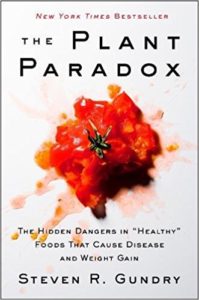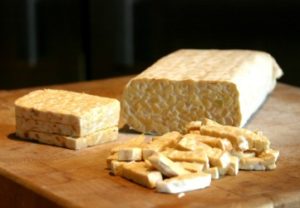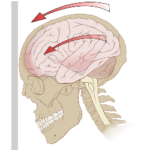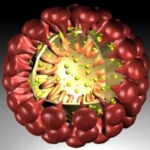
Lectins: The New Food Molecule to Avoid
Lectin molecules may be an important factor to consider in our quest to achieve optimal heath as they are possibly the reason for why so many people are experiencing difficulty eating certain foods. Never heard of lectins? Do you remember the blood type diet? The blood type diet was very popular about 10 years ago and posited that certain lectins would agglutinate blood and depending on your blood typ e, there would be foods more likely to create health problems if they had these lectins in them. The idea of lectins are getting a resurgence of interest ever since Dr. Seven Gundry’s new book, “The Plant Paradox”. In Dr. Gundry’s book he doesn’t seem to focus on blood types so much as recommending that lectins in general should be avoided.
e, there would be foods more likely to create health problems if they had these lectins in them. The idea of lectins are getting a resurgence of interest ever since Dr. Seven Gundry’s new book, “The Plant Paradox”. In Dr. Gundry’s book he doesn’t seem to focus on blood types so much as recommending that lectins in general should be avoided.
Scientists have been researching lectins for over 3-decades and what they have learned is that lectins act as a defense mechanism within plants. This defense mechanism acts to prevent microorganisms, pests, and insects from eating the plant that’s producing them. Their effects on these smaller organisms is more immediate and clear, however, in larger organisms like humans their effect has been more subtle.
Problems that Lectins Can Cause
- Damage gut lining creating ‘leaky gut’, which increases immune exposure to dietary and microbial proteins
- Create food allergies by potentiating immune response to normal otherwise non-reactive food proteins
- Indigestible to humans, enter our blood stream intact triggering immune responses.
- Cause autoimmunity via molecular mimicry (immune system cross-reactivity between lectins and normal tissue proteins)
- Stimulate mast cell degranulation, leading to histamine intolerance
Current research has the linked the various effects above to autoimmune illness, weight gain, cardiovascular disease, neurodegenerative disease, metabolic disorders (diabetes, PCOS, hyperlipidemia), skin disorders (eczema, psoriasis), etc.
Foods That Are High in Lectins
The following is an incomplete list and if interested in trying this diet, you should find a complete list of foods either through Dr. Gundry’s book or from our clinic. It is interesting that some of the highest lectin containing foods are also our top 8 most allergenic foods!
Egg
Wheat
Soy
Peanuts
Tree nuts
Tomatoes
All non-pasture raised animal products
Peppers
Melon
Squash
Pumpkin seeds
Cashews
Sunflower seeds
Most grains (especially whole grain)
Ancient Food Preparation Shows Avoidance of Lectins Isn’t New
 It’s always interesting to see traditional food preparation or food avoidance line up with what current research has to say about nutrition. Soaking beans and grains prior to cooking used to be common practice and has been gaining more acceptance among foodists. The act of soaking overnight will reduce a significant amount of lectins. Another ancient practice that reduces lectin quantity through microbial digestion is fermentation. Not only does fermentation reduce lectins, but also supports a healthy microbiome. Consider that not too long ago China still considered soy a non-food that was not to be consumed. Once it was found that it could be fermented, various soy ferment products were included as medicine due to the fermentation process making it healthy to consume. When it comes to lectin content of grains and seeds, sprouting can be effective and increase the digestibility in general. The simplest method of all for reducing lectin content is cooking. Cooking is also a great way to free up some bound nutrients.
It’s always interesting to see traditional food preparation or food avoidance line up with what current research has to say about nutrition. Soaking beans and grains prior to cooking used to be common practice and has been gaining more acceptance among foodists. The act of soaking overnight will reduce a significant amount of lectins. Another ancient practice that reduces lectin quantity through microbial digestion is fermentation. Not only does fermentation reduce lectins, but also supports a healthy microbiome. Consider that not too long ago China still considered soy a non-food that was not to be consumed. Once it was found that it could be fermented, various soy ferment products were included as medicine due to the fermentation process making it healthy to consume. When it comes to lectin content of grains and seeds, sprouting can be effective and increase the digestibility in general. The simplest method of all for reducing lectin content is cooking. Cooking is also a great way to free up some bound nutrients.
The low-lectin diet is promising in theory and thus far in clinical results. However, book store shelves are riddled with diet/nutrition books claiming that their diet is going to be the “magic” cure to weight loss or whatever ails you. For this reason, I am always cautiously optimistic and you will only hear more about this diet from me if and when I see consistently reproducible clinical results when putting patient’s on this diet. If you’re interested in this topic, I encourage you to pick up Dr. Gundry’s book called ‘The Plant Paradox’. It’s a good read, not as many cited references as I would have hoped, but still seems to have sufficient evidence to make a lot of the claims found in the book.


